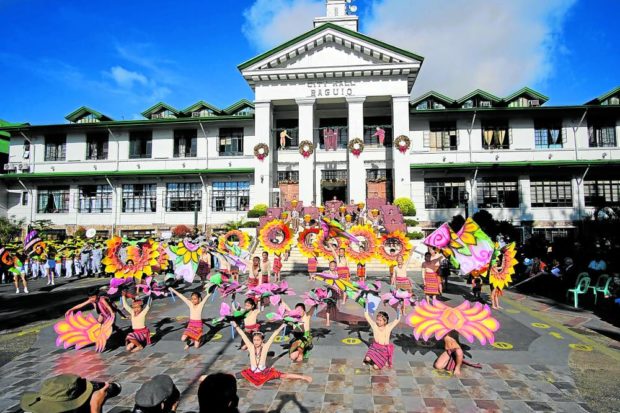
SNEAK PEEK | Students garbed in Cordillera attire and with flower-themed props perform a street dance in front of the Baguio City Hall on Monday as a preview to the main event for the tourist-drawing Panagbenga or Baguio Flower Festival that will be restaged in-person in late February next year. (Photo by NEIL CLARK ONGCHANGCO)
BAGUIO CITY, Benguet, Philippines — The city government offered its high-impact projects to businessmen on Monday, buoyed by a 9.9-percent growth last year and the return of prepandemic tourist events like street dancing and float parades of the next year’s Panagbenga or Flower Festival.
Mayor Benjamin Magalong on Monday described the resumption of 2023 activities, including the festival’s parades, as a “reset” for the city’s economy.
The lineup of the activities for the annual festival was also launched on Monday during the flag-raising ceremony at the City Hall.
Even if an increase in COVID-19 cases and other flu-like ailments was still being anticipated, the mayor said events like Panagbenga and future business ventures would proceed at full throttle because “we have to learn to live with these viruses and their subvariants.”
At an investment summit later in the day, Magalong also stressed that Baguio is one of the safest places under the prevailing pandemic because of its population’s high vaccination rate.
He assured businesses that “good governance has made traditional politics irrelevant” in Baguio and they can bring in projects without confronting corruption.
“The reason why you invest is because you can trust the local government,” he told the businessmen.
He noted that the city’s economy is nearing full recovery.
Bouncing back
The 2021 gross city domestic product (GCDP) of Baguio was valued at P139.2 billion, bouncing back from a 17.1-percent contraction or a GCDP of P126.7 billion when businesses were shuttered after the pandemic broke out in 2020, said Cordillera chief statistician Aldrin Federico Bahit Jr. of the Philippine Statistics Authority (PSA).
The GCDP is the sum total of goods and services that were generated in 2021.
The service sector had the highest growth rate at 6.4 percent last year, which includes accommodation and food service operations that cater to tourists, said Bahit when presenting the city’s 2021 performance at an economic briefing on Dec. 9.
He said Baguio’s hotel and food service industry was also one of the local industries which had the fastest growth in 2021.
Bahit said tourism is not only reflected in the service sector because “it cuts across other economic industries.” The PSA, for instance, is currently measuring how much water and electricity is consumed by Baguio visitors, he said.
According to the PSA, tourists who visited Baguio in 2020 spent P51.53 million, which was a negative 90.4-percent drop from “the inbound tourist expenditures of P537.17 million in 2019.”
The city planning office said tourist expenditures rose as high as P1.165 billion in 2016, spending P289.8 million on hotels and inns, P416 million on transportation, and P99 million on food and beverage services.
Chief tourism product
Panagbenga is one of the city’s chief tourism products, having drawn huge visitor numbers every February. It was conceived by Baguio civic leaders and businessmen in 1995 to lure investors and residents back to the city.
City Planning and Development Officer Donna Rimando Tabangin emphasized that the city’s economic drive would be tempered with policies and programs that protect Baguio’s remaining natural resources.
Tabangin, a member of a consultancy group that estimated Baguio’s carrying capacity in 2019, said many resources like water and transportation are no longer sufficient for the city’s current population of 366,358 (as of the 2020 census).
The city also has a daytime population that grows to 600,000 because of out-of-town businessmen, workers, and students living outside Baguio.